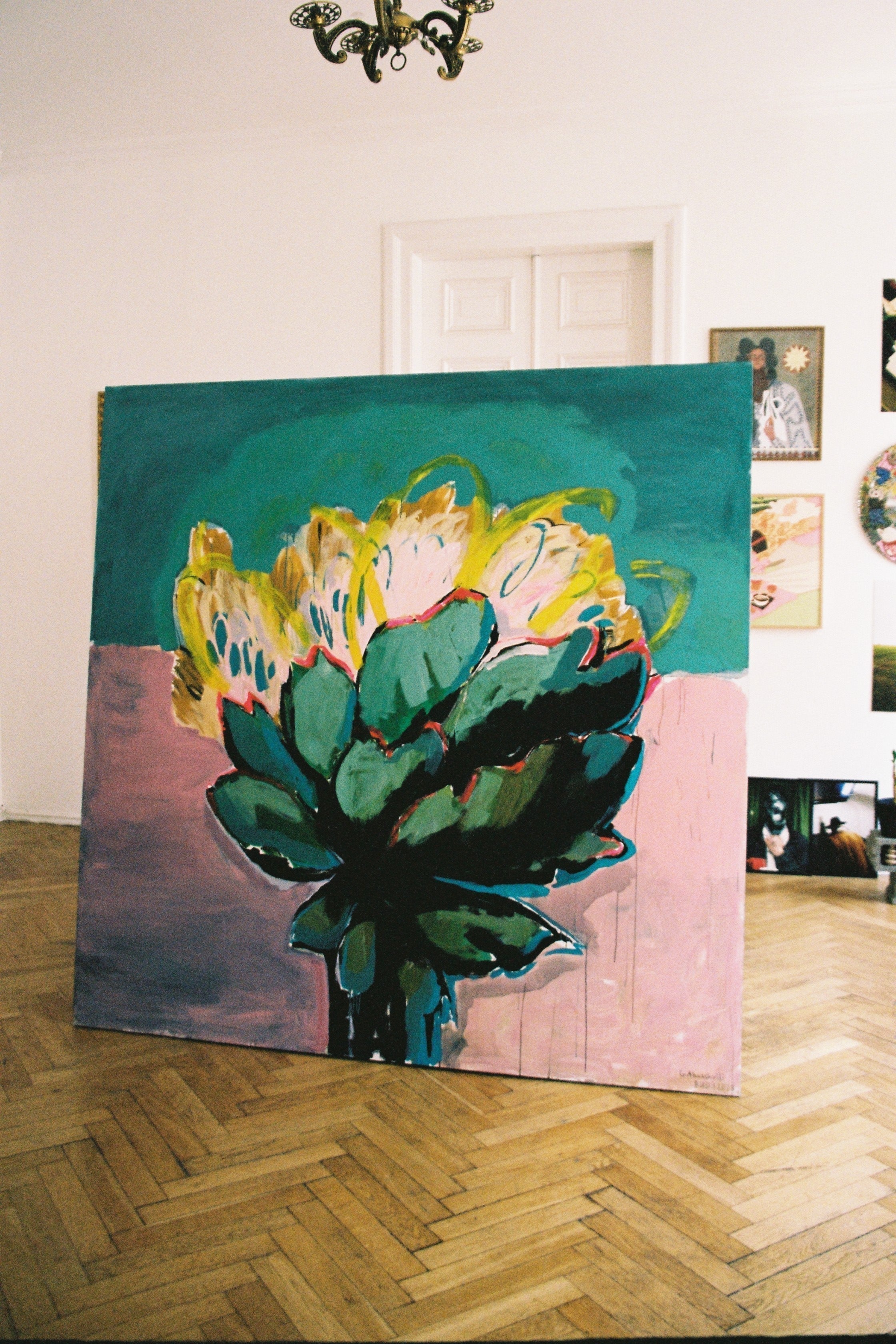ქართველი არტისტი გიორგი აბუაშვილი მოგზაურობას თავის შემოქმედების მთავარ წყაროდ მიიჩნევს. ფერები, ხმები, ქალაქების ქაოსი თუ ტაძრების სიმშვიდე, მის ტილოებზე ახალ ფორმებად და ემოციებად გარდაიქმნება. ჩვენს მოკლე ინტერვიუში, ოთხ კითხვაზე პასუხისას, ბუდუ საუბრობს მოგზაურობის გავლენაზე, მომავალ ექსპერიმენტებზე, რომლებსაც ინტერდისციპლინარულ ხელოვნებაში გეგმავს.
ოთხი შეკითხვა გიორგი აბუაშვილთან – მოგზაურობა, ფერები, გეგმები.
საიდან იწყება თითოეული ტილო და როგორ მოქმედებს ამ პროცესზე თქვენი მოგზაურობის გამოცდილება?
ჩემთვის თითოეული ტილო იწყება თითქოს უხილავი ბგერით ან ემოციით, რომელიც ჯერ სიტყვებში ვერ ჯდება. ხშირად ეს არის მოგზაურობისგან მიღებული შთაბეჭდილება,შეიძლება იყოს ფერთა შეხამება, ქუჩის ხმაური, წყლის მოძრაობა ან უბრალოდ მზის შუქის განსხვავებული ტონი. მაგალითად, მექსიკაში პირველად რომ დავინახე ოქროსფერი და ღრმა ლურჯის კონტრასტი ოახაკას ბაზარში, ეს იმდენად ძლიერად დამამახსოვრდა, რომ სწორედ ასეთი დიალოგი ფერებს შორის ხშირად ჩნდება ჩემს ნამუშევრებში. მოგზაურობები ჩემთვის გახსნაა: ყოველი ახალი ქალაქი ან ლანდშაფტი თითქოს საკუთარ „ენას“ მაძლევს, რომელსაც ტილოზე გადმოვიტან.
ოთხი შეკითხვა გიორგი აბუაშვილთან – მოგზაურობა, ფერები, გეგმები.
საიდან იწყება თითოეული ტილო და როგორ მოქმედებს ამ პროცესზე თქვენი მოგზაურობის გამოცდილება?
ჩემთვის თითოეული ტილო იწყება თითქოს უხილავი ბგერით ან ემოციით, რომელიც ჯერ სიტყვებში ვერ ჯდება. ხშირად ეს არის მოგზაურობისგან მიღებული შთაბეჭდილება,შეიძლება იყოს ფერთა შეხამება, ქუჩის ხმაური, წყლის მოძრაობა ან უბრალოდ მზის შუქის განსხვავებული ტონი. მაგალითად, მექსიკაში პირველად რომ დავინახე ოქროსფერი და ღრმა ლურჯის კონტრასტი ოახაკას ბაზარში, ეს იმდენად ძლიერად დამამახსოვრდა, რომ სწორედ ასეთი დიალოგი ფერებს შორის ხშირად ჩნდება ჩემს ნამუშევრებში. მოგზაურობები ჩემთვის გახსნაა: ყოველი ახალი ქალაქი ან ლანდშაფტი თითქოს საკუთარ „ენას“ მაძლევს, რომელსაც ტილოზე გადმოვიტან.

რომელი ქალაქი ან მოგზაურობის ისტორია გახსოვთ ყველაზე შთამაგონებლად და თუ გადაიქცა ეს გამოცდილება კონკრეტულ ნამუშევრებად?
ყველაზე ძლიერად მახსოვს ბრაზილიის ზღვისპირა ქალაქები – სალვადორი და რიო დე ჟანეირო. იქ ბუნება და ურბანული ქაოსი ისე ერთიანდება, თითქოს თვითონ ქალაქია ცოცხალი არსება. ფაველების მრავალფეროვანი ფერები და ზღვის უსასრულო ლურჯი ჩემთვის გახდა მეტაფორა ადამიანური ენერგიისა და ბუნების ჰარმონიისა. ამ გამოცდილებამ პირდაპირ წარმოშვა რამდენიმე ნამუშევარი, სადაც დინამიკა, არათანაბარი ხაზები და ინტენსიური ფერების შეჯახებაა. ასევე კამბოჯის ანგკორის ტაძრებმა ჩემზე დიდი შთაბეჭდილება მოახდინა, მათში დროის მატება და დაშლა ვიგრძენი, რამაც აბსტრაქციის ახალ განზომილებაში გადამიყვანა.
ყველაზე ძლიერად მახსოვს ბრაზილიის ზღვისპირა ქალაქები – სალვადორი და რიო დე ჟანეირო. იქ ბუნება და ურბანული ქაოსი ისე ერთიანდება, თითქოს თვითონ ქალაქია ცოცხალი არსება. ფაველების მრავალფეროვანი ფერები და ზღვის უსასრულო ლურჯი ჩემთვის გახდა მეტაფორა ადამიანური ენერგიისა და ბუნების ჰარმონიისა. ამ გამოცდილებამ პირდაპირ წარმოშვა რამდენიმე ნამუშევარი, სადაც დინამიკა, არათანაბარი ხაზები და ინტენსიური ფერების შეჯახებაა. ასევე კამბოჯის ანგკორის ტაძრებმა ჩემზე დიდი შთაბეჭდილება მოახდინა, მათში დროის მატება და დაშლა ვიგრძენი, რამაც აბსტრაქციის ახალ განზომილებაში გადამიყვანა.
მომავლისკენ რომ გაიხედოთ, რომელ ახალ მიმართულებებს ან ექსპერიმენტებს გეგმავთ და როგორ ფიქრობთ, სად მიგიყვანთ თქვენი ხელოვნება ხუთი წლის შემდეგ?
ვგრძნობ, რომ ჩემი შემდეგი ნაბიჯი უფრო მეტად მასშტაბური და ინტერდისციპლინარული იქნება. მინდა, რომ ფერწერა გაერთიანდეს სივრცესთან, მუსიკასთან და შეიძლება ციფრულ მედიათანაც, რათა გამოცდილება მთლიანად გარემოს მოიცავდეს. ვგეგმავ ექსპერიმენტებს ტექსტურებთან და ბუნებრივი მასალებთან, რადგან მგონია, რომ ბუნებისა და ხელოვნების დამაკავშირებელი ხაზი კიდევ უფრო უნდა გაღრმავდეს. ხუთი წლის შემდეგ ჩემი ხელოვნება ალბათ იქ იქნება, სადაც იგი შეძლებს არა მხოლოდ გალერეაში არსებობას, არამედ რეალურ სივრცეში, როგორც გამოცდილება, რომელიც მაყურებელს პირდაპირ ჩართავს იმ ემოციაში, რაც მე დამიტოვა მოგზაურობებმა მექსიკაში, ბრაზილიაში, ამერიკაში თუ კამბოჯაში.
ვგრძნობ, რომ ჩემი შემდეგი ნაბიჯი უფრო მეტად მასშტაბური და ინტერდისციპლინარული იქნება. მინდა, რომ ფერწერა გაერთიანდეს სივრცესთან, მუსიკასთან და შეიძლება ციფრულ მედიათანაც, რათა გამოცდილება მთლიანად გარემოს მოიცავდეს. ვგეგმავ ექსპერიმენტებს ტექსტურებთან და ბუნებრივი მასალებთან, რადგან მგონია, რომ ბუნებისა და ხელოვნების დამაკავშირებელი ხაზი კიდევ უფრო უნდა გაღრმავდეს. ხუთი წლის შემდეგ ჩემი ხელოვნება ალბათ იქ იქნება, სადაც იგი შეძლებს არა მხოლოდ გალერეაში არსებობას, არამედ რეალურ სივრცეში, როგორც გამოცდილება, რომელიც მაყურებელს პირდაპირ ჩართავს იმ ემოციაში, რაც მე დამიტოვა მოგზაურობებმა მექსიკაში, ბრაზილიაში, ამერიკაში თუ კამბოჯაში.
